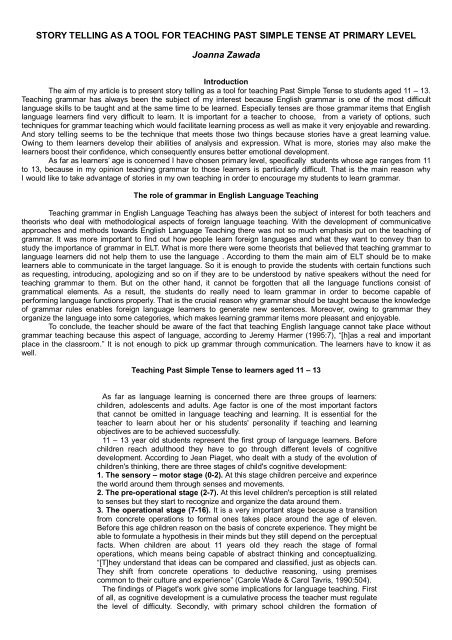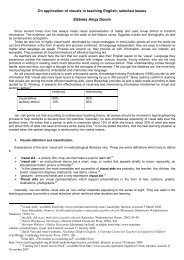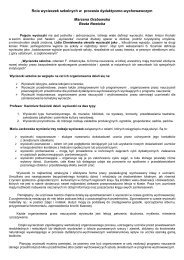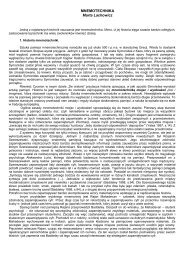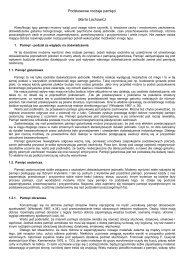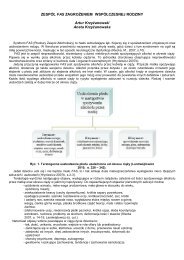STORY TELLING AS A TOOL FOR TEACHING PAST SIMPLE ...
STORY TELLING AS A TOOL FOR TEACHING PAST SIMPLE ...
STORY TELLING AS A TOOL FOR TEACHING PAST SIMPLE ...
You also want an ePaper? Increase the reach of your titles
YUMPU automatically turns print PDFs into web optimized ePapers that Google loves.
<strong>STORY</strong> <strong>TELLING</strong> <strong>AS</strong> A <strong>TOOL</strong> <strong>FOR</strong> <strong>TEACHING</strong> P<strong>AS</strong>T <strong>SIMPLE</strong> TENSE AT PRIMARY LEVEL<br />
Joanna Zawada<br />
Introduction<br />
The aim of my article is to present story telling as a tool for teaching Past Simple Tense to students aged 11 – 13.<br />
Teaching grammar has always been the subject of my interest because English grammar is one of the most difficult<br />
language skills to be taught and at the same time to be learned. Especially tenses are those grammar items that English<br />
language learners find very difficult to learn. It is important for a teacher to choose, from a variety of options, such<br />
techniques for grammar teaching which would facilitate learning process as well as make it very enjoyable and rewarding.<br />
And story telling seems to be the technique that meets those two things because stories have a great learning value.<br />
Owing to them learners develop their abilities of analysis and expression. What is more, stories may also make the<br />
learners boost their confidence, which consequently ensures better emotional development.<br />
As far as learners’ age is concerned I have chosen primary level, specifically students whose age ranges from 11<br />
to 13, because in my opinion teaching grammar to those learners is particularly difficult. That is the main reason why<br />
I would like to take advantage of stories in my own teaching in order to encourage my students to learn grammar.<br />
The role of grammar in English Language Teaching<br />
Teaching grammar in English Language Teaching has always been the subject of interest for both teachers and<br />
theorists who deal with methodological aspects of foreign language teaching. With the development of communicative<br />
approaches and methods towards English Language Teaching there was not so much emphasis put on the teaching of<br />
grammar. It was more important to find out how people learn foreign languages and what they want to convey than to<br />
study the importance of grammar in ELT. What is more there were some theorists that believed that teaching grammar to<br />
language learners did not help them to use the language . According to them the main aim of ELT should be to make<br />
learners able to communicate in the target language. So it is enough to provide the students with certain functions such<br />
as requesting, introducing, apologizing and so on if they are to be understood by native speakers without the need for<br />
teaching grammar to them. But on the other hand, it cannot be forgotten that all the language functions consist of<br />
grammatical elements. As a result, the students do really need to learn grammar in order to become capable of<br />
performing language functions properly. That is the crucial reason why grammar should be taught because the knowledge<br />
of grammar rules enables foreign language learners to generate new sentences. Moreover, owing to grammar they<br />
organize the language into some categories, which makes learning grammar items more pleasant and enjoyable.<br />
To conclude, the teacher should be aware of the fact that teaching English language cannot take place without<br />
grammar teaching because this aspect of language, according to Jeremy Harmer (1995:7), “[h]as a real and important<br />
place in the classroom.” It is not enough to pick up grammar through communication. The learners have to know it as<br />
well.<br />
Teaching Past Simple Tense to learners aged 11 – 13<br />
As far as language learning is concerned there are three groups of learners:<br />
children, adolescents and adults. Age factor is one of the most important factors<br />
that cannot be omitted in language teaching and learning. It is essential for the<br />
teacher to learn about her or his students' personality if teaching and learning<br />
objectives are to be achieved successfully.<br />
11 – 13 year old students represent the first group of language learners. Before<br />
children reach adulthood they have to go through different levels of cognitive<br />
development. According to Jean Piaget, who dealt with a study of the evolution of<br />
children's thinking, there are three stages of child's cognitive development:<br />
1. The sensory – motor stage (0-2). At this stage children perceive and experince<br />
the world around them through senses and movements.<br />
2. The pre-operational stage (2-7). At this level children's perception is still related<br />
to senses but they start to recognize and organize the data around them.<br />
3. The operational stage (7-16). It is a very important stage because a transition<br />
from concrete operations to formal ones takes place around the age of eleven.<br />
Before this age children reason on the basis of concrete experience. They might be<br />
able to formulate a hypothesis in their minds but they still depend on the perceptual<br />
facts. When children are about 11 years old they reach the stage of formal<br />
operations, which means being capable of abstract thinking and conceptualizing.<br />
“[T]hey understand that ideas can be compared and classified, just as objects can.<br />
They shift from concrete operations to deductive reasoning, using premises<br />
common to their culture and experience” (Carole Wade & Carol Tavris, 1990:504).<br />
The findings of Piaget's work give some implications for language teaching. First<br />
of all, as cognitive development is a cumulative process the teacher must regulate<br />
the level of difficulty. Secondly, with primary school children the formation of
concepts needs to be assisted by practical and verbal experience.<br />
Another factor that cannot be omitted when describing characteristic features of<br />
students whose age ranges from 11 to 13 is connected with neurological<br />
considerations. Because of the laterlalization of the brain, certain functions are<br />
assigned to the right or the left hemisphere. It means that both hemispheres do not<br />
process the same function in a similar way and consequently language is not<br />
acquired similarly by the two parts of the brain. The teacher has to be aware of the<br />
fact that there are two types of learners in the class: right-brain dominant and leftbrain<br />
dominant. Such division requires that the teacher must take into account<br />
different learning styles of students when planning a lesson.<br />
Other important features of primary level students are openness to new<br />
experiences and eagerness to learn about something new. But on the other hand,<br />
11-13 year olds have rather short attention span. That inability to concentrate on a<br />
task for a longer time “forces” the teacher to use short and varied activities if he or<br />
she does not want his or her students to get bored. What is more, 11-13 aged<br />
learners have also short memory span. The fact that primary level students learn<br />
quickly but at the same time they forget quickly demands that the teacher uses a<br />
variety of memory techniques such as repeating, questioning and pausing. Those<br />
techniques will prompt learners to think on material more sufficiently.<br />
As for the material it has to be relevant in terms of students' age and their level of<br />
cognitive development. It is a very crucial aspect of foreign language teaching<br />
because “...[c]hildren best remember those things that appeal directly to their own<br />
experience and feelings” (David Fontana, 1988:136).<br />
To sum up, successful foreign language teaching is not possible without the<br />
knowledge of the learner' s personality. The teacher has to be aware of character<br />
features of his/her students if he/she wants to achieve educational objectives.<br />
Moreover, the understanding of the students' personality may help the teacher to<br />
recognize their strengths and weaknesses, which plays an important role in<br />
teaching process. On the other hand, learners also take advantage of that<br />
knowledge because owing to it the teacher develops and improves his/her teaching<br />
techniques. That is why the issue of the language learner's personality needs to be<br />
taken into consideration if both teaching and learning processes are due to<br />
succeed.<br />
Story telling as a tool for teaching Past Simple Tense<br />
Grammar teaching techniques can be divided into two main categories:<br />
discovery techniques and practice techniques. The first ones are those where<br />
learners are provided with examples of language and asked to find out how they<br />
work. Matching techinques, text study and problem-solving are the most typical<br />
discovery techniques, whereas drills, interaction-based techniques, games and<br />
written practice belong to the second category. When using them the teacher<br />
makes his/her students practise language forms they are familiar with. Each of<br />
those techniques has its limitations in terms of students' age, their level of cognitive<br />
development and foreign language knowledge. But there is one grammar teaching<br />
method that seems to be suitable for all English language learners no matter how<br />
old they are and how much of English they already know. This is story telling which,<br />
as a pedagogical tool, has been used by many teachers and philosophers such as<br />
Jesus and Confucius. There are many reasons why teachers should take<br />
advantage of stories in their classes.<br />
First of all, they give students opportunities of listening to grammar items in<br />
context rather than in pieces and bits as it takes place for example in drills. It is a<br />
very important aspect of story telling because students better acquire grammar<br />
items if they are contextualised. Moreover, the above mentioned items are often<br />
introduced within associated networks, which makes learning more<br />
comprehensible. The fact that learners have opportunities to deal with real<br />
language of communication, not a typical teacher's talk used in foreign language<br />
classes, makes story telling superior to other grammar teaching techniques. In fact,<br />
there are no other language materials that would use as a variety of language (<br />
from colloquial to literary) as stories do.<br />
Secondly, when the teacher uses story telling not only do students practise and<br />
develop listening and reading skills but they also absorb new vocabulary and<br />
grammatical structures. Owing to the repetition of key words and grammar phrases<br />
they acquire the language in a greater way and as a result they start to master it<br />
somehow at the first stage of using stories, that is while listening to them.<br />
Thirdly, when learners listen to stories they have to use their cognitive powers<br />
and reasoning processes in order to understand the meaning of a text. This makes<br />
them more involved, concentrated and at the same time more interested in
lessons. This active participation not only ensures better language acquisition but<br />
also gives a wonderful feeling of a task achievement that cannot be compared with<br />
a satisfaction when doing not very creative drills or other typical grammar practice<br />
activities.<br />
Furthermore, stories have great educational values because they may provide<br />
students with the knowledge on various issues considering our life. Very often they<br />
contain a message that due to its timeless nature may make children change their<br />
beliefs, attitudes or behaviour for better.<br />
Finally, using story telling in foreign language teaching can be beneficial for social<br />
and emotional develpoment because thanks to stories students gain insight into<br />
characters' motives. And this helps them to become more sensitive, understanding<br />
and tolerant towards other people.<br />
All the above mentioned arguments show how learners can benefit from story<br />
telling rather than how it may come in handy for the teacher who is going to use it<br />
as a tool for teaching Past Simple Tense at primary level. As there are lots of<br />
aspects that make story telling a useful teaching technique the next paragraphs will<br />
present this method from the teacher's point of view, that is how he/she can use<br />
and develop it in the classroom.<br />
To start with, when introducing the story to students the teacher can use various<br />
techniques (e.g reading aloud, using cassette tapes or CDs) and materials<br />
(e.g.pictures, realia). Such diversity of props and methods will definitely guarantee<br />
students' involvement in classes. It may aslo enhance their learning abilities<br />
because different senses are activated at one time. What happens in the story<br />
students experience by means of their eyes (when looking at illustrations), ears<br />
(when listening to recordings) or bodies (when imitating characters' gestures).<br />
There are not many grammar teaching techniques that take advantage of all the<br />
three kinds of senses (visual, auditory and kinesthetic) to such a great extent as<br />
story telling does. Even if some of them do, such as problem-solving or interactionbased<br />
techniques, they are not much suitable for primary level students because<br />
they are too difficult.<br />
Secondly, there is a great number of stories in which the use of past for narrative<br />
is often . As a result the teacher has no problems with finding materials for classes.<br />
Moreover, he/she can choose such a story that , in terms of its length and<br />
complexity, would fit students' needs.<br />
Finally, there is also a great variety of activities the teacher can develop on the<br />
basis of stories. Not only do they help learners to acquire Past Simple Tense and<br />
practise it in many ways but also make lessons more attractive to them as well as<br />
more involving them. Since a large number of English language learners find<br />
learning and practising grammar boring, the teacher has to put great effort into the<br />
preparation of grammar exercises if he/she does not want students to get bored<br />
and discouraged. And story telling, due to its variety of interesting uses, can bring<br />
many benefits to the teacher. The most important are attractiveness of classes,<br />
students' involvement and interest, and teacher's satisfaction with a well done job.<br />
In conclusion, teaching grammar is not a very easy task for the teacher because<br />
a great number of learners find this aspect of language very difficult to learn. That<br />
is why choosing the right grammar teaching technique may play a crucial role if the<br />
teacher wants to achieve his/her educational objectives successfully. Story telling, if<br />
used properly, can become a great tool for teaching Past Simple Tense to students<br />
aged 11-13 because not only is it an effective and enjoyable way of teaching<br />
language but also thanks to it children forget their worries and anxieties about<br />
grammar.<br />
References<br />
Brown, Eowyn. ”Using children's literature with young learners”. (http://iteslj.org/Techniques/Brown-ChildrensLit.html)<br />
(date of access: 31 Jan.2006).<br />
Brown, H. Douglas. 1987. Principles of language learning and teaching. (2 nd edition.) New Jersey: Prentice Hall<br />
Regents.<br />
Child, Dennis. 1986.Psychology and the teacher. London: Cassell.<br />
Fontana, David. 1988. Psychology for teachers. Leicester: The British Psychological Society.<br />
Harmer, Jeremy. 1991. The practice of English language teaching. (New edition.) Edinburgh Gate: Pearson Education<br />
Limited.<br />
Harmer, Jeremy. 1995.Teaching and learning grammar. Harlow: Longman Group UK Limited.<br />
Harmer, Jeremy. 1999. How to teach English. Edinburgh Gate: Pearson Education Limited.<br />
Pedersen, E. Martin. “Storytelling and the art of teaching”. (http://exchanges.state.gov/forum/vols/vol33/no1/P2.htm) (date<br />
of access:31 Jan. 2006).<br />
Quirk, Randolph – Sidney Greenbaum. 1990. A concise grammar of contemporary English. Edinburgh Gate: Pearson<br />
Education Limited.
Thornburry, Scott. 2003. How to teach grammar. Edinburgh Gate: Pearson Education Limited.<br />
Ur, Penny. 1988. Grammar Practice Activities – A practical guide for teachers. Cambridge: Cambridge University Press.<br />
Wade, Carole – Carol Tavris. 1990. Psychology. New York: Harper & Row, Publishers.<br />
Wright, Andrew. 2003. Creating stories with children. Oxford: Oxford University Press.


